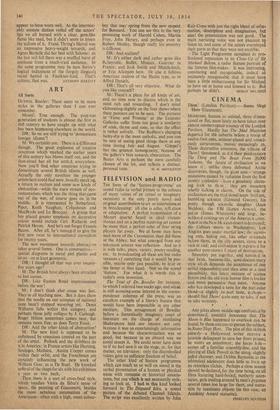ART
DUTIFUL Reader: There seem to be more styles in the galleries than I can ever remember.
Myself: True enough. The post-war generation of students is almost the first in thi§ country to have caught up with what has been happening elsewhere in the world.
DR: So we are still trying to 'domesticate foreign idioms'?
M : We certainly are. There is a el:fference though. The great explosion of creative invention which marked the earlier years of this century has blown itself out, and the dust-cloud has all but settled, everywhere. Now you'll find other countries trying to domesticate several British idioms as well. Actually the only novelties the younger artists here could find were, broadly speaking, a return to realism and some new kinds of abstraction—while the main stream of Iwo- romanticism; which was the thing that came out of the war, of course goes on in the middle. It is represented by Sutherland. Piper, Keith Vaughan, Colquhoun and MacBryde and Le Brocquy. A. group that has placed greater emphasis on decorative colour would include Ceri Richards and Patrick Heron. And let's not forget Francis Bacon. After all, he's managed to give the first new twist to international surrealism for twenty years.
The new movement towards abstraet'en takes several forms. One is constructivis. — spatial diagrams in metal and plastic and so on—or at least geometric.
DR: I thought all that was over twenty- five years ago?
M: The British have always been attracted to lost causes.
DR: Like Euston Road impressionism before the war!
M: I don't think that cause was lost. They're all teaching now. But it does show that the needle on our compass of national taste hasn't stopped wavering yet. Denis Williams falls within this category, and perhaps those jolly collages by .1. Catleugh. Roger Hilton sometimes comes near, but remains more free, as does Terry Frost.
DR : And the other kinds of abstraction? M: The new kind is supposed to be unfettered by conscious control on the part of the artist. Pollock and the dribblers do it in America; in France artists like Hartung, Soulages, Mathieu. Austin Cooper comes within their orbit, and the Frenchmen arc certainly influencing the new work of William Gear, as is De Steel. He knocked several of the chaps for six with his exhibition a year or two back.
Then there is a sort of cross-bred style, which touches Vieira da Silva's' sense of key that may spring from the new respect for Bonnard. You can see this in the very promising work of Harold Cohen, Martin Froy, John Hersey, and perhaps even in Robert Medley, though really his ancestry is different.
DR: And realism?
M: It's either dark and rather grim like Rebeyrolle, Buffet, Minaux, Guerrier in France; and Jack Smith and Middleditch, or Eric Atkinson here. Or else it follows American realism of the Shahn type, as in Alfred Daniels.
DR: That's all very objective. What do you like yourself?
M: There's a place for all kinds of art, and no time now to discuss which is the most rich and rewarding. I don't mind elaborating slightly on the four shows where these painters are to be seen. The pictures in Fame and Promise' at the Leicester Galleries suffer from too great a similarity of scale, theme and toile, so that the effect is rather unlivcly. The Redfern's changing lucky-dip is the most catholic, and you can be sure of seeing good things there at any time during July and August. Gimpel's has the greatest homogeneity, because of the gallery's bias towards abstraction. The Beaux Arts is perhaps the most carefully chosen of the lot, and reflects a distinct,


































 Previous page
Previous page